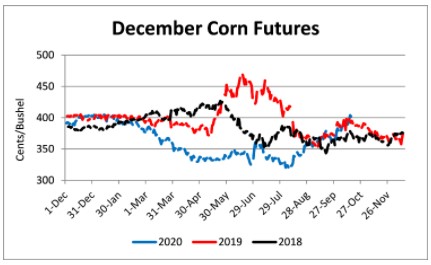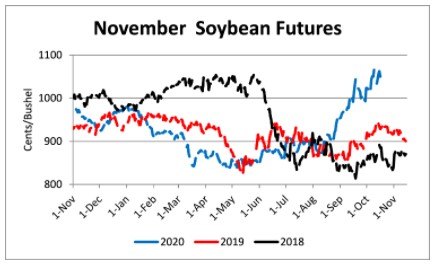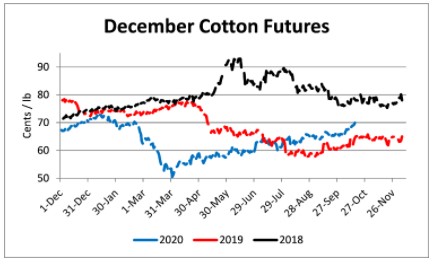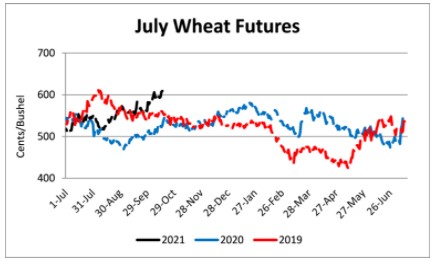Ethanol production for the week ending October 9 was 0.937 million barrels per day, up 14,000 barrels from the previous week. Ethanol stocks were 20.008 million barrels, up 0.336 million barrels compared to last week. Corn net sales reported by exporters for October 2-8 were down compared to last week with net sales of 25.8 million bushels for the 2020/21 marketing year. Exports for the same time period were down 13% from last week at 32.1 million bushels. Corn export sales and commitments were 45% of the USDA estimated total exports for the 2020/21 marketing year (September 1 to August 31) compared to the previous 5-year average of 31%.
Corn | Dec 20 | Change | Mar 21 | Change |
Price | $4.02 | $0.07 | $4.07 | $0.05 |
Support | $3.97 | $0.16 | $4.02 | $0.13 |
Resistance | $4.11 | $0.14 | $4.14 | $0.09 |
20 Day MA | $3.81 | $0.06 | $3.89 | $0.05 |
50 Day MA | $3.63 | $0.07 | $3.73 | $0.07 |
100 Day MA | $3.51 | $0.03 | $3.61 | $0.03 |
4-Week High | $4.09 | $0.11 | $4.12 | $0.07 |
4-Week Low | $3.60 | $0.01 | $3.69 | $0.00 |
Technical Trend | Up | = | Up | = |
Nationally the Crop Progress report estimated corn condition at 61% good-to-excellent and 14% poor-to-very poor; corn mature at 94% compared to 87% last week, 69% last year, and a 5-year average of 87%; and corn harvested at 41% compared to 25% last week, 20% last year, and a 5-year average of 32%. In Tennessee, the Crop Progress report estimated corn condition at 72% good-to-excellent and 4% poor-to-very poor; corn mature at 100% compared to 96% last week, 100% last year, and a 5-year average of 99%; and corn harvested at 76% compared to 60% last week, 91% last year, and a 5-year average of 89%. Across Tennessee, average corn basis (cash price-nearby futures price) weakened or remained unchanged at Mississippi River, North-Central, and Northwest, and strengthened at West-Central and West elevators and barge point. Overall, basis for the week ranged from 20 under to 22 over, with an average of 7 over the December futures. December 2020 corn futures closed at $4.02, up 7 cents since last Friday. For the week, December 2020 corn futures traded between $3.87 and $4.09. Dec/Mar and Dec/Dec future spreads were 5 and -7 cents. Downside price protection could be obtained by purchasing a $4.05 December 2020 Put Option costing 14 cents establishing a $3.91 futures floor. In Tennessee, new crop cash corn contracts ranged from $3.76 to $4.39. March 2021 corn futures closed at $4.07, up 5 cents since last Friday. December 2021 corn futures closed at $3.95, down 1 cent since last Friday.

Soybeans
Net sales reported by exporters were up compared to last week with net sales of 96.7 million bushels for the 2020/21 marketing year. Exports for the same period were down 8% compared to last week at 87.6 million bushels. Soybean export sales and commitments were 72% of the USDA estimated total annual exports for the 2020/21 marketing year (September 1 to August 31), compared to the previous 5-year average of 45%.
Soybeans | Nov 20 | Change | Jan 21 | Change |
Price | $10.50 | -$0.15 | $10.50 | -$0.15 |
Support | $10.34 | -$0.01 | $10.35 | $0.03 |
Resistance | $10.78 | $0.02 | $10.78 | $0.03 |
20 Day MA | $10.29 | $0.08 | $10.32 | $0.08 |
50 Day MA | $9.77 | $0.16 | $9.82 | $0.16 |
100 Day MA | $9.29 | $0.09 | $9.34 | $0.10 |
4-Week High | $10.79 | $0.00 | $10.77 | $0.00 |
4-Week Low | $9.85 | $0.11 | $9.90 | $0.12 |
Technical Trend | Up | = | Up | = |
Nationally the Crop Progress report estimated soybean condition at 63% good-to-excellent and 11% poor-to-very poor; soybeans dropping leaves at 93% compared to 85% last week, 81% last year, and a 5-year average of 90%; and soybeans harvested at 61% compared to 38% last week, 23% last year, and a 5-year average of 42%. In Tennessee, soybean condition was estimated at 75% good-to-excellent and 4% poor-to-very poor; soybeans dropping leaves at 81% compared to 69% last week, 90% last year, and a 5-year average of 89%; and soybeans harvested at 31% compared to 21% last week, 47% last year, and a 5-year average of 40%. Across Tennessee, average soybean basis weakened or remained unchanged at Mississippi River, West, West-Central, North-Central, and Northwest elevators and barge points. Basis ranged from 10 under to 20 over the November futures contract. Average basis at the end of the week was 10 over the November futures contract. November 2020 soybean futures closed at $10.50, down 15 cents since last Friday. For the week, November 2020 soybean futures traded between $10.31 and $10.73. Nov/Jan and Nov/Nov future spreads were 0 and -80 cents. November/December soybean-to-corn price ratio was 2.61 at the end of the week. In Tennessee, new crop soybean cash contracts ranged from $10.34 to $10.98. January 2021 soybean futures closed at $10.50, down 15 cents since last Friday. November 2021 soybean futures closed at $9.70, down 10 cents since last Friday. Downside price protection could be achieved by purchasing a $9.80 November 2020 Put Option which would cost 65 cents and set a $9.15 futures floor. Nov/Dec 2021 soybean-to-corn price ratio was 2.46 at the end of the week.

Cotton
Net sales reported by exporters were down compared to last week with net sales of 98,900 bales for the 2020/21 marketing year and 13,200 bales for the 2021/22 marketing year. Exports for the same time period were up 35% compared to last week at 192,600 bales. Upland cotton export sales were 61% of the USDA estimated total annual exports for the 2020/21 marketing year (August 1 to July 31), compared to the previous 5-year average of 54%. Delta upland cotton spot price quotes for October 15 were 65.47 cents/lb (41-4-34) and 67.72 cents/lb (31-3-35). Adjusted World Price (AWP) increased 1.95 cents to 53.43 cents.
Cotton | Dec 20 | Change | Mar 21 | Change |
Price | 69.92 | 2.28 | 70.56 | 2.14 |
Support | 68.61 | 2.17 | 69.35 | 1.69 |
Resistance | 70.69 | 1.87 | 71.31 | 1.53 |
20 Day MA | 66.84 | 0.70 | 67.64 | 0.69 |
50 Day MA | 65.47 | 0.51 | 66.33 | 0.52 |
100 Day MA | 63.35 | 0.54 | 64.11 | 0.53 |
4-Week High | 70.04 | 1.36 | 70.70 | 1.30 |
4-Week Low | 64.65 | 0.47 | 65.48 | 0.28 |
Technical Trend | Up | = | Up | = |
Nationally, the Crop Progress report estimated cotton condition at 40% good-to-excellent and 30% poor-to-very poor; cotton bolls opening at 90% compared to 83% last week, 86% last year, and a 5-year average of 75%; and cotton harvested at 26% compared to 17% last week, 30% last year, and a 5-year average of 27%. In Tennessee, cotton condition was estimated at 61% good-to-excellent and 19% poor-to-very poor; cotton bolls opening at 91% compared to 85% last week, 92% last year, and a 5-year average of 94%; and cotton harvested at 18% compared to 7% last week, 31% last year, and a 5-year average 30%. December 2020 cotton futures closed at 69.92, up 2.28 cents since last Friday. For the week, December 2020 cotton futures traded between 68.02 and 70.04 cents. Dec/Mar and Dec/Dec cotton futures spreads were 0.64 cents and -0.40 cents. Downside price protection could be obtained by purchasing a 70 cent December 2020 Put Option costing 1.62 cents establishing a 68.38 cent futures floor. March 2021 cotton futures closed at 70.56 cents, up 2.14 cents since last Friday. December 2021 cotton futures closed at 69.52 cents, up 1.99 cents since last Friday.

Wheat
Wheat net sales reported by exporters were up compared to last week with net sales of 19.4 million bushels for the 2020/21 marketing year and 2.6 million bushels for the 2021/22 marketing year. Exports for the same time period were down 28% from last week at 18.6 million bushels. Wheat export sales were 57% of the USDA estimated total annual exports for the 2020/21 marketing year (June 1 to May 31), compared to the previous 5-year average of 57%.
Wheat | Dec 20 | Change | Jul 21 | Change |
Price | $6.25 | $0.32 | $6.09 | $0.15 |
Support | $6.08 | $0.30 | $5.97 | $0.16 |
Resistance | $6.39 | $0.14 | $6.18 | $0.03 |
20 Day MA | $5.79 | $0.14 | $5.82 | $0.09 |
50 Day MA | $5.53 | $0.09 | $5.62 | $0.06 |
100 Day MA | $5.36 | $0.04 | $5.47 | $0.04 |
4-Week High | $6.30 | $0.14 | $6.12 | $0.03 |
4-Week Low | $5.37 | $0.04 | $5.50 | $0.03 |
Technical Trend | Up | = | Up | = |
Nationally the Crop Progress report estimated winter wheat planted at 68% compared to 52% last week, 61% last year, and a 5-year average of 61%; and winter wheat emerged at 41% compared to 24% last week, 37% last year, and 5-year average of 35%. In Tennessee winter wheat planted was estimated at 24% compared to 11% last week, 21% last year, and a 5-year average of 23%; and winter wheat emerged at 9% compared to 5% last week, 6% last year, and a 5-year average of 6%. December 2020 wheat futures closed at $6.25, up 32 cents since last Friday. December 2020 wheat futures traded between $5.87 and $6.30 this week. December wheat-to-corn price ratio was 1.55. Dec/Mar and Dec/Jul future spreads were -2 and -16 cents. March 2021 wheat futures closed at $6.23, up 26 cents since last Friday. In Tennessee, new crop wheat cash contracts ranged from $5.80 to $6.17. July 2021 wheat futures closed at $6.09, up 15 cents since last Friday. Downside price protection could be obtained by purchasing a $6.10 July 2021 Put Option costing 43 cents establishing a $5.67 futures floor.

Source : tennessee.edu